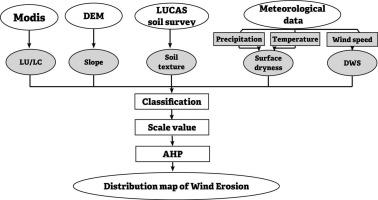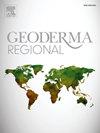Wind erosion escalation in western Slovakia driven by climate and land use and land cover shifts
IF 3.1
2区 农林科学
Q2 SOIL SCIENCE
引用次数: 0
Abstract
Wind erosion is a major cause of soil degradation and air pollution and is influenced by climate and land use factors. Understanding the mechanisms behind wind erosion dynamics is crucial for mitigating its harmful effects. This study employs an integrated approach, combining the Analytic Hierarchy Process (AHP) methodology and local knowledge, to comprehensively assess wind erosion in the western region of Slovakia from 2001 to 2021. Using GIS-based AHP, the study assessed the spatial distribution of areas at high risk of wind erosion based on six parameters: wind speed, surface dryness, land use, land cover, soil texture, and field slope. A multicollinearity test was conducted to examine the collinearity of the chosen factors, and it was seen that none of the factors were compromised by multicollinearity. The results showed a significant increase in the risk of wind erosion in the study area over the past 20 years, with very high erosion risk in 2007, 2014, and 2021 increasing by 37 %, 86 %, and 128 %, respectively, compared to 2001. Statistical analyses confirm the significant impact of surface dryness, wind speed, land use, and land cover on wind erosion, emphasizing the need for targeted strategies to mitigate erosion risk. The regression analysis underscores the negative relationship between land use and wind erosion, emphasizing the pivotal role of land management in erosion prevention. These findings contribute valuable insights to the discourse on sustainable land use practices and erosion mitigation, particularly in the context of evolving climate dynamics.

气候、土地利用和土地覆盖变化导致斯洛伐克西部风蚀加剧
风蚀是土壤退化和空气污染的主要原因,并受到气候和土地使用因素的影响。了解风蚀动态背后的机制对于减轻其有害影响至关重要。本研究采用综合方法,结合层次分析法(AHP)和当地知识,对斯洛伐克西部地区 2001 年至 2021 年的风蚀情况进行了全面评估。该研究利用基于地理信息系统的层次分析法,根据风速、地表干燥度、土地利用、土地覆盖、土壤质地和田间坡度这六个参数,评估了风蚀高风险地区的空间分布。对所选因子进行了多重共线性检验,以考察其共线性,结果表明没有一个因子存在多重共线性。结果表明,在过去 20 年中,研究区域的风蚀风险显著增加,与 2001 年相比,2007 年、2014 年和 2021 年的极高风蚀风险分别增加了 37%、86% 和 128%。统计分析证实了地表干燥度、风速、土地利用和土地覆盖对风蚀的显著影响,强调了有必要采取有针对性的策略来降低风蚀风险。回归分析凸显了土地利用与风蚀之间的负相关关系,强调了土地管理在预防侵蚀中的关键作用。这些发现为有关可持续土地利用实践和减少侵蚀的讨论提供了宝贵的见解,尤其是在气候动态不断变化的背景下。
本文章由计算机程序翻译,如有差异,请以英文原文为准。
求助全文
约1分钟内获得全文
求助全文
来源期刊

Geoderma Regional
Agricultural and Biological Sciences-Soil Science
CiteScore
6.10
自引率
7.30%
发文量
122
审稿时长
76 days
期刊介绍:
Global issues require studies and solutions on national and regional levels. Geoderma Regional focuses on studies that increase understanding and advance our scientific knowledge of soils in all regions of the world. The journal embraces every aspect of soil science and welcomes reviews of regional progress.
 求助内容:
求助内容: 应助结果提醒方式:
应助结果提醒方式:


